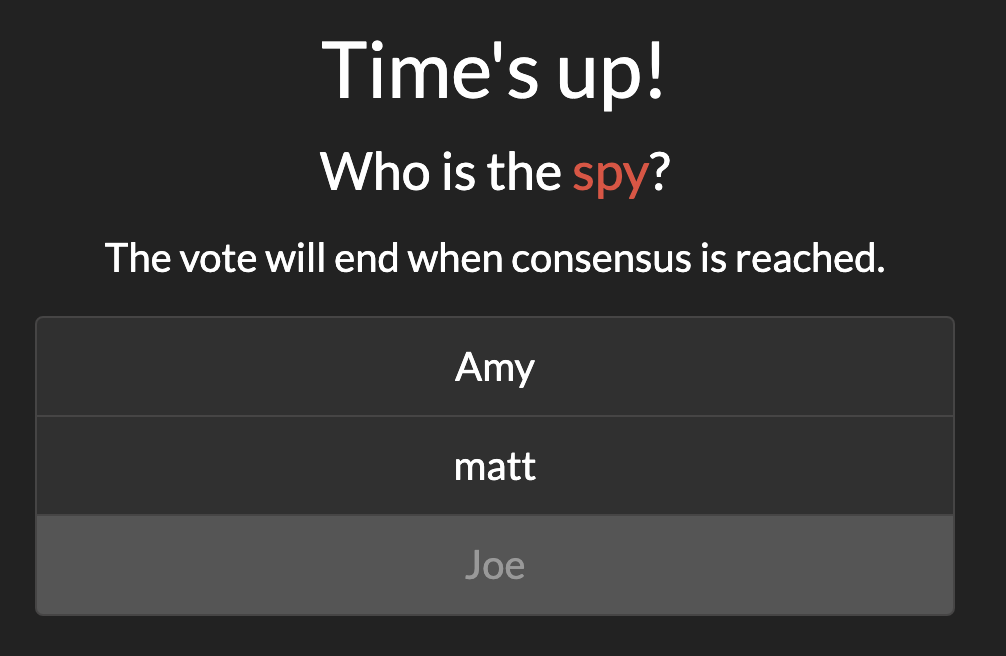SpyFall is social deception game created by Alexandr Ushan in 2013. The target audience of SpyFall on the original card game is 13+, or any age group where people are sufficient at lying.

The version of Spyfall I played was adapted for web and hosted on Netgames.io, which is a digital board and card game platform that was created by Luke Tsekouras.
Notable elements of the game
Introduction
SpyFall is a social deception game that is best played in groups of 3 – 8 people. In the game, there are two types of players: the spy and non-spies.
The premise of the game is that everyone except the spy in the game knows a certain location, and the spy wants to avoid getting caught.
- Non-spies ask and answer questions in order to determine who is the spy.
- Spies try to guess the right location by inferring from others’ questions and answers in order to sneakily avoid getting caught.
Notably, in this Critical Play, I will discuss the digital adaptation of SpyFall to the browser.
How do rounds work?

Before a round starts, players enter the game by entering a four digit code to join the game room on Netgames.io.



From left to right: 1. Scroll to reveal your identity. 2. You are not the spy and a location. 3. You are the spy.
In each round, everyone is first given a card that shows them whether or not they are the spy. Then, everyone but the spy is given a location.
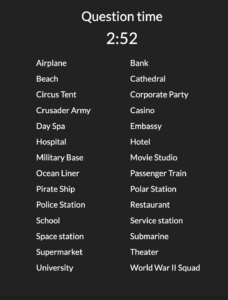
When the timer starts, everyone is given a list of available locations. The leader of the game starts the questioning by asking another player about the location. Whoever is asked a question must answer without any follow-up questions, and then it is their turn to ask someone else a question. They must choose a different person to ask a question. This process of asking and answering questions continues until the time runs out.
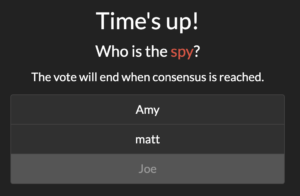
After the time runs out, someone can accuse a player of being a spy. If the group reaches a consensus by voting, the player who has been accused must reveal their identity. If this is not the spy, the spy receives a point.
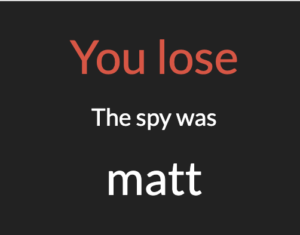

In these screen-grabs, the spy won the game by avoiding the consensus vote.
If this is the spy, the spy tries guessing the secret location. If they are correct, then only the spy receives a point. If they are incorrect, all non-spies receive a point.
Formal Elements
Examining the formal element of players, SpyFall is a unilateral competition between the spy and the larger group. The larger group of non-spies work together to try to unmask the spy and win as a group. On the other end, the spy is working against the group to try to stay hidden and guess the correct location.
However, I noticed that the game can also feel like a multilateral competition in the beginning of each round, when people are unsure of who the spy is and have to protect their own identity. There is a change in dynamic in player interactions from multilateral competition to unilateral competition as the round progresses and there is more evidence for a certain player being the spy.
Next, the objective of the game is outwit the other players. The spy wants to outwit the non-spies and the non-spies want to outwit the spy. Both types of players ask and answer questions to gain more information for their goal.

Third, an interesting resource that enhances gameplay is the resource of time in each round. With a limited amount of time in each round, players are quickly forced to make fast judgments and more player interactions in order to score points. Because of the time constraint, on-spies want to figure out who the spy is sooner in order to be able to reach a consensus and vote the spy out before the spy figures out the right location.
This constraint aids the formal element of conflict; by limiting the amount of time in each round, this increases opportunity for dilemmas, in which non-spies must make the choice on who to accuse as spy and spies must determine the right location and when they should reveal themselves.
The boundary of the game exists in the magic circle of people’s minds, based on the roles that people are dealt. This creates an interesting interaction as some people may really feel absorbed in their role, and some players may not!
“As a pretty bad liar, I felt it was difficult for me to succeed when I was the spy in this game, but it was fun to rise up to the challenge.”
Compared to the genre
Compared to other social deception games in the genre, SpyFall is differentiated by the brevity and design of its rounds. Other social deception games like Werewolf, Mafia, and Among Us vote or kill players off of each round, and players keep their roles in each round. However, in SpyFall, the round ends when one person is accused as spy or the spy reveals themself, and players can have different roles each round.
When I compared SpyFall to Among Us, a social deception game I’ve played before, I played I found that it was less interesting for me because I had less opportunities to interact with the game. In Among Us, you are responsible for your task, but you are also responsible for observing and staying aware of what other players are doing around you. However, in SpyFall, if you are not being asked any questions as a non-spy, the only thing you can really do is observe other players to see if they are the spy. This is less engaging than Among Us, where you can still play small mini-games or explore the map.
Comparing SpyFall to Werewolf, which we played in class, I thought that the lack of complexity in roles made Spyfall feel less fun than Werewolf. There are only two roles in SpyFall (spy or non-spy), whereas other social deception games like Werewolf have more than one that interact with each other or are dependent on each other. I received the same role, non-spy, multiple times in a row.
“It was boring to play over time because I didn’t get as many opportunities to be the spy and manipulate or lie for fun.”
On the other hand, having only two roles to play in the game also made it easier for me to learn the game as a new player. Werewolf has multiple roles that can get confusing to explain. It was easy for me and others who hadn’t played SpyFall before to pick up on the game mechanics.
Was the game fun?
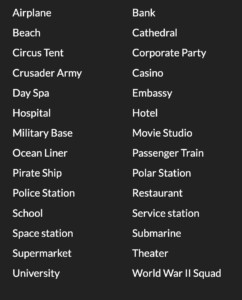
The game was fun to play at first, but since I only played with three players, it got boring quickly after a few rounds. With fewer players, it was easier to guess who the spy was because there were less people to question in the round under the time limit.
Additionally, the Netgames.io adaptation of SpyFall had a limited amount of locations that were the same across all rounds, so players quickly designed questions and patterns to probe at the spy over time. Since it was easier to guess the spy, the lack of challenge after a few rounds made the game feel less novel over time.
In reflection, the game could have been more fun had I played with a larger group. Having only three players made the game less fun since the likelihood of guessing the spy correct was higher. From a pure probabilistic standpoint, having more players decreases the chance you’ll get the spy right – which is all part of the fun!
Key moments
Particular Success
- I loved the interaction of sliding up the card on the browser to reveal what role I had! I felt suspense each time from the dramatic reveal.
- When I asked vague questions to try to trick the spy, it succeeded! I had to strategize my questions and ask them carefully to avoid revealing the location.
Epic Fails
- I was the spy twice in a row. I was unable to succeed as the spy since the questions people asked were extremely specific after a few rounds of playing and we had all already gotten a feel for each others’ giveaways for lying.
- At first, I accidentally revealed too much information in my question as the non-spy, which made it easy for the spy to guess the location!
Things I would change
- After a few rounds, it was easier as the spy to determine what the locations were based on previous questions asked in the past. To make the game harder (and more fun), I would increase the types of categories beyond locations or increase the number of locations to make it harder to guess the location for the spy. Another idea would be to randomize the types of locations available.
- With smaller groups, I would decrease the amount of time for a round so it is more difficult for the spy and non-spy to get information. With 3 people, we had too much time to ask and answer questions such that we were guessing the spy before the round was over.
- It would be interesting to have a series of locations or objects, not just one. This would make it more challenging to communicate about several different things to make it more difficult for the players.
- Reaching consensus could get into a deadlock if there were conflicting opinions on who was the spy. I think changing this to a majority vote would make it easier to end a round when people get stuck.
- While we kept track of the points on paper, it would be helpful if the digital adaptation on Netgames.io had a way of tracking our points. This would incentivize people to play more than one round if they saw they did not have as many points as other players.


